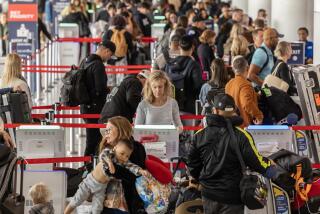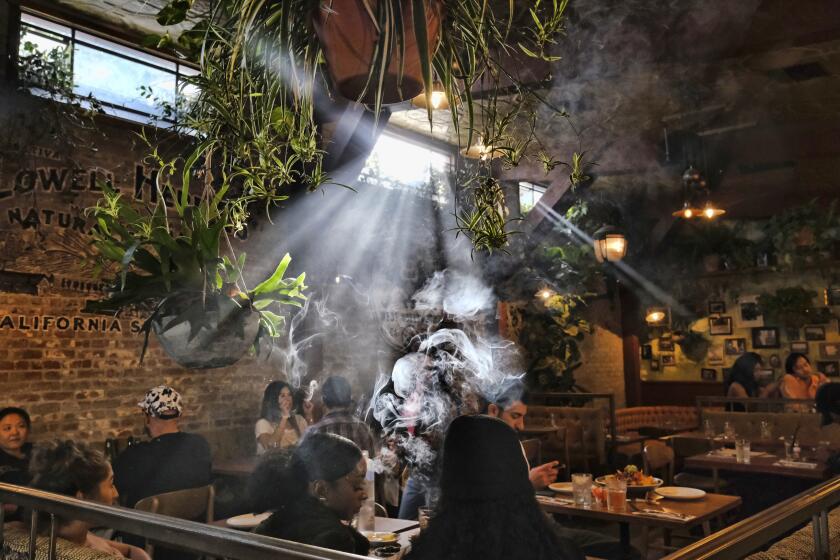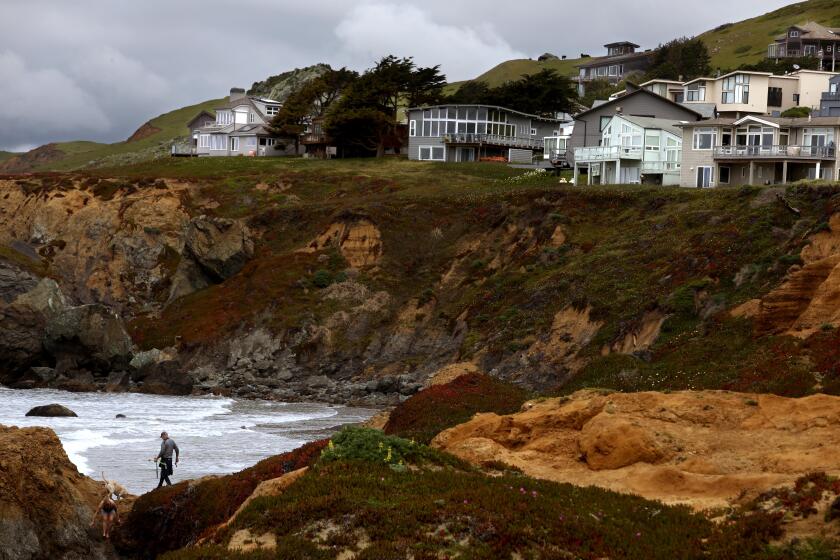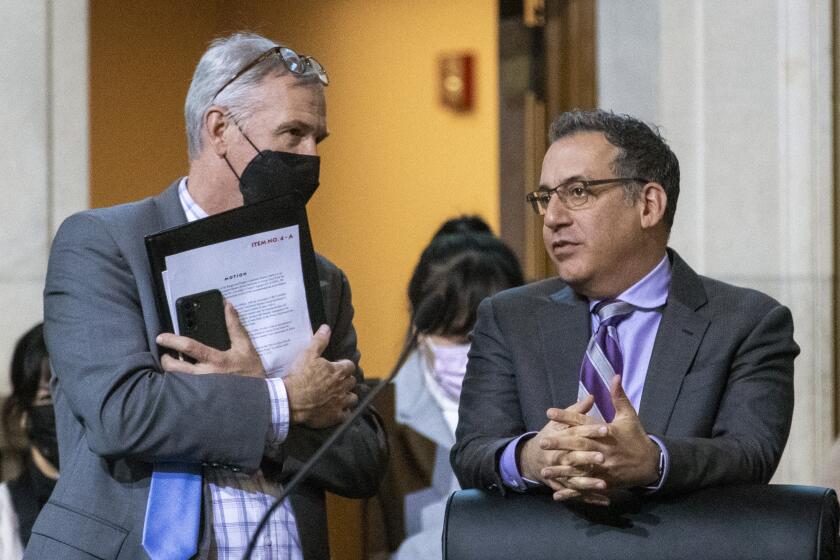ELECTIONS / THOUSAND OAKS : Future of Boulevard Emerges as Key Issue
The debate has been brewing for years: what to do about Thousand Oaks Boulevard. Should the city spruce up its oldest thoroughfare, line it with brick sidewalks and potted plants, try to make it more like State Street in Santa Barbara?
Or should Thousand Oaks leave the boulevard alone, letting free market economics, rather than government planning, decide the future of the street?
It’s a divisive issue that will probably be one of the first facing the winning candidate for the fifth seat on the Thousand Oaks City Council this June 6.
This summer a committee of business owners and city staffers plans to present the council with a list of ideas for redesigning Thousand Oaks Boulevard gathered from community meetings and discussions, including five workshops on Friday and Saturday.
*
The council will be left to decide whether to accept all the proposals politely and then stash them in a drawer somewhere to gather dust, or whether to use them to develop a specific plan for the boulevard’s future.
The six candidates are sharply divided on the answer.
Self-employed businessman Ekbal (Nick) Quidwai calls the redesign concept a farce and believes the city government should stay out of it completely.
“I don’t think it needs government help,” Quidwai said. “Why should the government be involved? Stand back and maybe waive fees for redevelopment or something, but that’s all.”
Others, including attorney Trudi Loh and engineer John Ellis, want to limit the city’s involvement to planting trees or improving sidewalks and drains. Still others, particularly mobile carwash owner Lance Winslow, are eyeing an empty lot on the boulevard across from the Civic Arts Plaza for redevelopment.
*
Whatever is done should start soon, said Compton homicide Detective Mike Markey.
“I do think something needs to be done,” said Markey, who is making his third attempt for a council seat. “Thousand Oaks Boulevard needs to be a central, focal point in the community.
“I don’t think it should go another four or five years,” Markey said. “It’s always easy to say why you shouldn’t do something. But it would be a lot more positive to say how can we do it and make it a team effort.”
The Thousand Oaks Boulevard redesign issue must be handled delicately. Businesses along the boulevard are an important part of the city’s tax base, contributing $1.1 million in sales tax revenues to city coffers out of a total of nearly $13 million citywide in 1993-94.
Even though some merchants have been deeply involved in the
redesign process, many business owners have harshly criticized suggestions for a revitalized downtown.
Markey said more input is needed from business owners.
“They are what our community thrives on,” he said. “They are the life cycle of this community. We need to have their input so we don’t push their business away. We’ve got to listen to them.”
*
Winslow, making his second bid for a council seat after coming in ninth in the fall campaign, also made a pitch for better teamwork in redesigning the boulevard. To that end, he called for the end of criticism directed at Francisco Behr, a local architect who has been an active member of the redesign committee. Many of the old-time boulevard merchants complain that Behr is trying to change their street to suit his tastes.
“I don’t think Francisco should be criticized,” Winslow said. “I don’t think that is right. He really cares. When you have someone like that wanting to help you, you really don’t want to bad-mouth him.”
Winslow, who owns a mobile carwash business, favors a slow approach to revitalizing the boulevard, beginning with using a group of vacant lots across the street from the Civic Arts Plaza. He said he thinks the city should encourage a developer to purchase several lots at once and turn the block into a mini-mall with shops, restaurants and outdoor areas for walking.
Whether the city would partially fund such a project is something Winslow remains undecided about.
“If it looked like you could generate a lot of sales tax revenue from it, yes,” he said. “But if not, you would let the free market do it.
“Too much change too soon is not good,” he added. “If someone buys that big parcel, that’s a start. If that worked out real good, then you can kind of go from there.”
*
Loh, making her first bid for council after narrowly losing to Frank Schillo in the supervisor’s race last fall, said the city government must be careful not to tread on the toes of the business owners. Two members of her campaign advisory committee are boulevard merchants who oppose the redesign concept.
“There are limits to what a government can or should do there,” she said. “The city shouldn’t tell merchants, ‘You can’t sell tires anymore, you need to sell shoes.’ That’s absurd.”
Instead, she said the city should act as a conduit for information to business owners, filling them in what types of businesses might be needed along the boulevard, then letting the market determine what happens there.
“For instance, we don’t have as many restaurants along the boulevard as we can use,” Loh said. “That doesn’t take a survey to discover, it only takes trying to go out to dinner once. Let’s put some faith in the private sector and let them resolve that issue.”
The city should spend redevelopment money on ensuring streets and sidewalks are well maintained and improving the overall appearance of the area, Loh said. Additionally, she would favor a tree planting program, encouraging community involvement.
“Tree planting would be something that makes people feel part of the community and enhances the attractiveness of the boulevard at the same time,” she said. “But it’s not exactly a falling-down heap as it is.”
The boulevard’s appearance is of utmost importance to Ramaul Rush, a juvenile courts dependency counselor making his first run for a council seat.
*
“In the middle of the boulevard there are older buildings that don’t seem quite in sync or in character with the other end of the boulevard,” Rush said. “I would like to see that addressed.”
While the council should have a say in what happens to the boulevard, Rush said the business owners should have the final word.
Real estate broker and engineer John Ellis said he thinks the boulevard needs a structural overhaul more than anything else.
“It needs a good refurbishment of streets, sidewalks and drainage, the whole infrastructure,” Ellis said. “Then I think to a great extent it should be left alone.”
“The infrastructure should be the priority,” he added. “If any funds are left over, then you start talking about making things more beautiful. One thing the government should stay out of is telling businesses what to do.”
Ellis said he thinks some factions in the city are trying to make the rest of the boulevard more compatible with the new $64-million Civic Arts Plaza, which looms over several weed-filled empty lots and shut-down businesses.
“They want to make it beautiful so that when people drive down to the Civic Arts Plaza, they’ll think, oh, isn’t this nice,” Ellis said. “At the same time, businesses may be boarding up their windows because that is not typically the kind of traffic you want on a business street.”
Quidwai too has questions about the Civic Arts Plaza and its role in plans to redesign. But he takes an even harder line, expressing disgust that the city’s Redevelopment Agency, which largely funded the Civic Arts Plaza, was ever created.
“It’s the biggest scam west of the Mississippi,” Quidwai said.
After the area was declared blighted in 1979, the city was able to keep a healthy portion of property taxes paid by landowners along Thousand Oaks Boulevard, ostensibly to fund the area’s revitalization.
But Quidwai says he does not think the area is blighted at all. Any improvements should be made by the private sector, he said.
Of highest concern to Quidwai is the still unsold acreage next to the Civic Arts Plaza. He thinks the city should push harder to sell the land, which is fenced off to the public and still looks like a construction site.
And he said the millions borrowed by the city from the Redevelopment Agency to fund construction of the building should be repaid to the agency’s depleted accounts immediately.
Loh also questions the financial standing of the Redevelopment Agency.
“One of the reasons we declared that a redevelopment area was to put money back into the commercial corridor,” she said. “The majority of that money has gone into the Civic Arts Plaza. So before we get starry-eyed about some grand plan there, let’s look at the realities of what is left in that redevelopment fund.”
Markey suggests funding the improvements with federal beautification grants, block grants and money raised from cultural events, including street fairs, as well as using whatever redevelopment funds are available.
Even though he favors making aesthetic improvements to the boulevard and thinks funding could be shared between public and private sectors, Rush said he would not make those changes a top priority if elected.
“I think really people today are more concerned about job security and having food on the table at this point,” Rush said. “Those are things that we really have to consider as a priority.”
More to Read
Start your day right
Sign up for Essential California for news, features and recommendations from the L.A. Times and beyond in your inbox six days a week.
You may occasionally receive promotional content from the Los Angeles Times.






